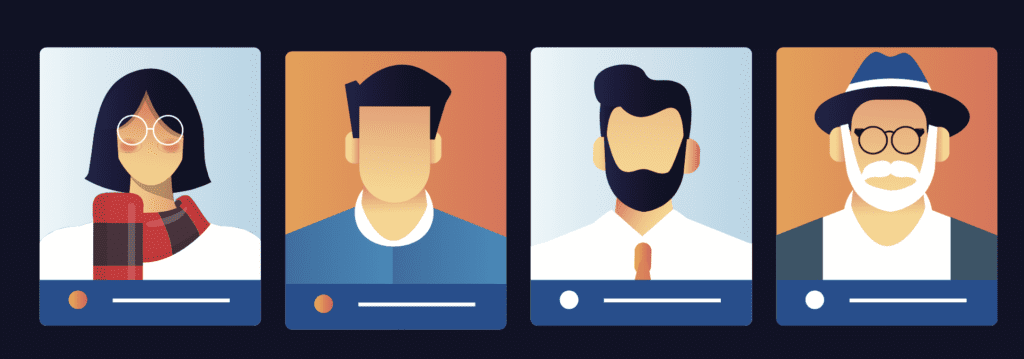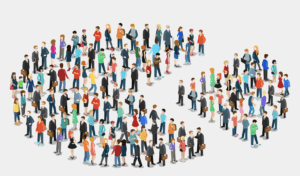Personas, segments and target groups - what is what
Dividing large groups of recipients - your customers - into smaller groups creates target groups as well as segments and personas. The common goal: to get to know your customers better and to address them in a personalised way. But what are the differences and when do you need what? This blog post will tell you.
What are segments?
Not all potential customers in a market are equally attractive to your company: Customers with higher incomes, for example, will be quicker to grab a replacement for a particular product and will also spend more money. Other customer groups are more attractive because they buy a product or use a service again and again - so-called regular customers. On the other hand, there are customers who will not purchase a certain product because, for example, they consider the product superfluous, the product does not meet all their needs, or they do not know the product at all.
That is why you should break down the entire market of all customers and potential customers into smaller units or subsets - into segments. Depending on the source, these segments are called customer segments, market segments or target group segments in marketing. Therefore, be aware that some of your employees or colleagues may use these terms interchangeably.
What does market segmentation mean?

jirsak / Adobe Stock
Bruhn describes market segmentation in his book Marketing. Grundlagen für Studium und Praxis: "a division of the 'relevant market' into homogeneous segments or submarkets [...]. It represents the basis of a differentiated market development." (S. 58).
The resulting segments are then referred to as market segments, customer segments or target group segments, depending on the source. We refrain from using the term "target group segments" in this article because target groups can also be segmented - i.e., subdivided. In this way, we want to avoid any confusion.
You can split the relevant market based on vendor, product or service characteristics, as well as customer characteristics. An example: you offer an online marketplace for used furniture, for example. Here, you first roughly divide into two segments: sellers and buyers.
What is a target group?

Blue Planet Studio / Adobe Stock
You will not (be able to and want to) address all parts of your market. This is why the term "target group" is used in marketing. This refers to the recipients of the communication measures - in other words, all the customers in your customer segment whom you can and want to address directly with marketing, advertising and corporate communications. Another characteristic of target groups: they include not only current and potential buyers, but all persons who can exert an influence on the buyers' decisions are of interest. These can be opinion leaders, influencers or reference persons, for example. An example: for a travel guide publisher, the target groups would be all people who use printed and digital travel guides for vacation planning or on vacation. However, recipients of brand communication can also be so-called travel influencers. These are people who report on their travel experiences online, for example on a travel blog or on Instagram. They exert a great influence on potential customers and therefore count as part of the target group.
When forming target groups, customers with one or more of the same characteristics are grouped together, e.g., people who use travel guides. The advantage: target groups can be easily analyzed and described.
But be careful: Usually, even within target groups, there is another segmentation, e.g. according to demographic characteristics or turnover. For our example of travel guides, such segmentation could result in these sub-target groups: Individual travelers, app travelers, digital nomad travelers, etc. This gives you even more specific sub-target groups that form the basis for personas. These sub-target groups are often also referred to as target group segments.
What are target group segments?
Target group segments are both the submarkets resulting from a market segmentation and subgroups or sub-target groups of a target group. The term is therefore ambiguous.
What are personas?

robikucluk / Adobe Stock
data-driven personas (also called buyer personas) are representative of target groups or sub-target groups. In other words, a persona represents a stereotype that is intended to be as representative as possible of a specific target group. Personas provide insights into usage patterns, customer journey, motivation of consumers and into their concerns, wishes, hobbies and values.
A profile of the persona can be read on the basis of a profile (also called a persona profile or sedcard). A classic persona profile contains a name - for better identification, the age, place of residence and marital status of the persona. But also interests, values, character and consumption habits are often named.
You can find sample personas on our website, for example: https://www.persona-institut.de/beispielpersonas/
A data-driven persona is more concrete than target groups, sub-target groups and market segments. It shows a specific proxy with its most important characteristics, values, desires and peculiarities. Its goal: to make the target group tangible and alive. Personas give consumers a face: vivid prototype personalities are developed from abstract data.
Personas are particularly successful in targeting (potential) customers because they help to think from the customer's perspective. Integrating personas into the business strategy usually leads to success after a short time. You can also find more information about personas on our website, our blog or in our eBook.
Differences and similarities between market segments, target groups and personas
In the last section we explained what market segmentation, target groups and personas are. But how do they differ and do they have commonalities?
Common ground
Overall, it can be said that all three methods serve to divide the market into units or subsets. The customers within a subset are as homogeneous as possible, while the subsets differ from each other in one or more characteristics. The subdivision helps to plan corporate measures such as advertising, marketing, PR and communication in a more targeted way. Market segmentation can also be useful in product development and customer service.
Another common feature: All three methods should be based on known data that can be easily obtained, e.g., through internal surveys and analyses (e.g., website tracking) or through external studies, data, and statistics (e.g., from Statista or the German Federal Statistical Office). In this process, data is first collected and then people who are similar in particularly relevant characteristics are clustered, i.e. grouped by machine or manually.
Important: To generate maximum added value, the number of units should always remain manageable. Whether personas, market segments, or target groups - the rule is always: use as many as necessary and as few as possible.
Differences
In marketing planning, market segmentation helps to determine the optimal combination of different marketing instruments. This can look different for each market segment. In the case of target groups, it is then a matter of addressing the various customer groups within a market segment with suitable communication instruments and appropriate distribution channels. Conceptually, target groups are on a lower level than market segments.
Personas and target groups can be easily separated from each other because personas think from the consumer's point of view, i.e. from the customer's perspective. This is also called the bottom-up principle. Target groups and market segments, on the other hand, approach the customer using the top-down principle - i.e. they first think from the company's point of view.
Another difference: market segments and target groups are rough, categorical classifications of customer groups, while personas focus on specific details of person types, e.g. experiences, goals, motivations and values. In other words, personas aim to understand customers on a personal level, while target groups form a coarser classification that is less detailed and provides a basis for higher-level communication measures in particular. In practice, this means, for example: Based on the target group, the company knows which social media are used (e.g. Instagram and Facebook). With the help of different personas, the right network and the right approach can be found for each persona (e.g. 20-year-old Anna likes to watch Instagram stories, while 60-year-old Thomas prefers to discuss in Facebook groups).
Conclusion

Sentavio / Adobe Stock
With market segmentation, you divide existing and potential buyers into subgroups - so-called market segments or customer segments. Based on this, target groups can be developed, which in turn can be segmented into sub-target groups, for example according to customer characteristics, attitudes, buying behaviour or socio-demographic characteristics. The basic set of target groups is not only buyers and potential buyers, but also all persons who could influence the decision-making process of buyers and potential buyers.
The breakdown into target groups and segments helps to predict the market acceptance of a product or service and to understand what encourages customers to buy. In addition, target groups form the basis for communication measures. But when it comes to tailoring the product or service, determining functions, and putting yourself in the customer's perspective - personas help. Personas are target group representatives. Unlike target groups and market segments, they provide concrete, detailed information and become specific.
For example, a target group description reads: "Male students, 18 to 25 years old, tech-savvy, future-oriented," while the excerpt of a persona-sedcard might read: "Jonas, 22 years old: Jonas studies electrical engineering and is enthusiastic about new developments in technology and IT in his free time. Besides his studies, he likes to tinker with robots and read up on the subject of space travel. He describes himself as a 'nerd'". This graphic shows you another example of the differences between personas and target groups:
All market subdivision variants serve to get to know your customers better in order to adjust product development, customer journey and marketing in a targeted manner.
Latest comments